PHE2AHR Assignment: Body Image in Children, Gender, and Age
VerifiedAdded on 2022/11/22
|15
|4201
|401
Report
AI Summary
This report, prepared for a PHE2AHR assignment at La Trobe University, investigates the complex relationship between body image, gender, and age in children aged 8 to 13. The study, employing a cross-sectional design, surveyed 339 participants from 10 schools using the Social Physique Anxiety Scale (SPAS-C) and questionnaires. The findings reveal that female participants reported greater concerns about their body image compared to males, and older children showed increased body image worries, although this increase wasn't consistent across all age groups. The report explores the dimensions of muscularity, social physique anxiety, and body esteem, providing insights into how these factors are influenced by gender and age. The study also includes qualitative data from focus groups, offering potential explanations for the observed differences in body image perceptions. The report highlights the importance of understanding these dynamics for addressing potential physical and psychological health issues in young people.
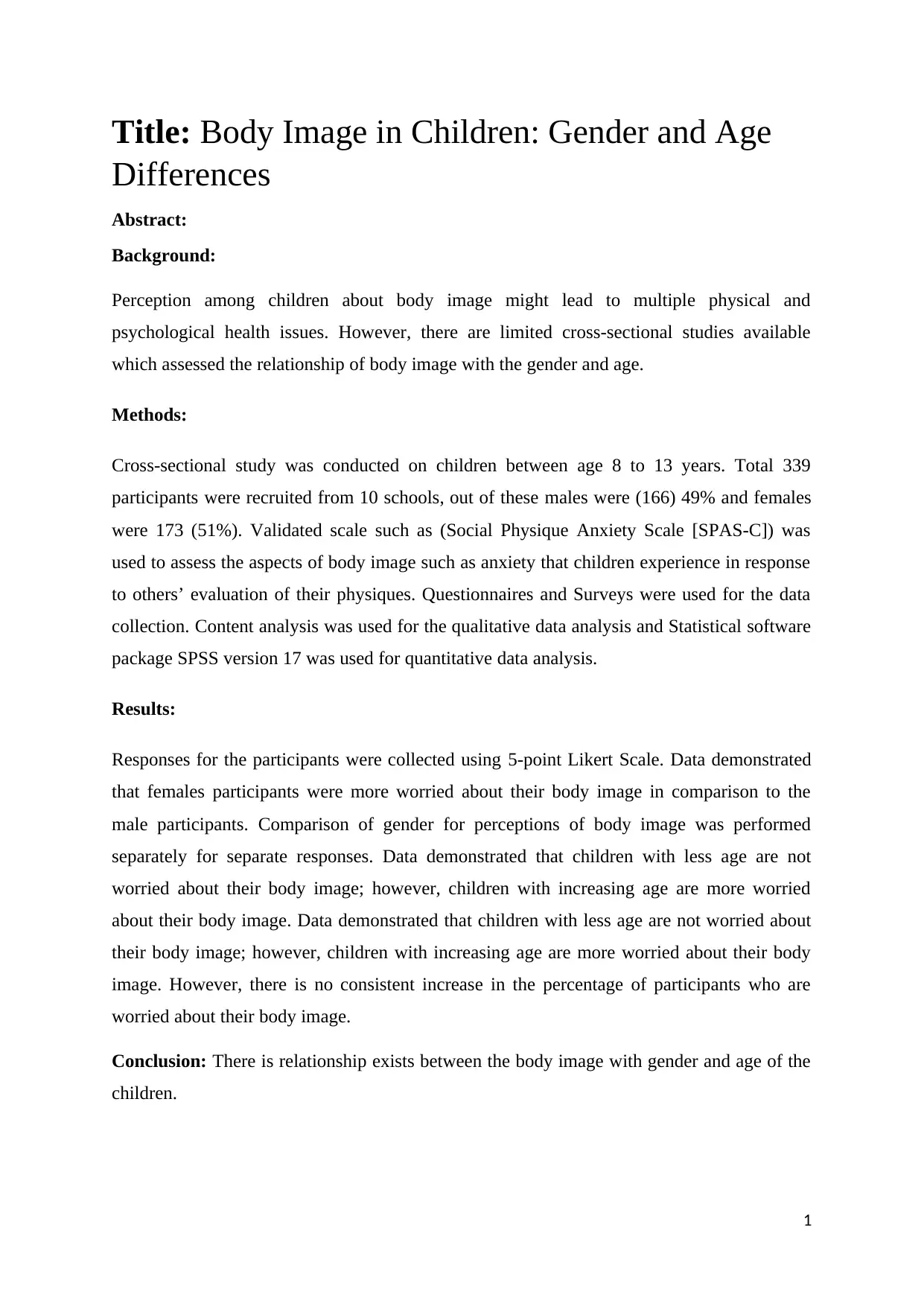
Title: Body Image in Children: Gender and Age
Differences
Abstract:
Background:
Perception among children about body image might lead to multiple physical and
psychological health issues. However, there are limited cross-sectional studies available
which assessed the relationship of body image with the gender and age.
Methods:
Cross-sectional study was conducted on children between age 8 to 13 years. Total 339
participants were recruited from 10 schools, out of these males were (166) 49% and females
were 173 (51%). Validated scale such as (Social Physique Anxiety Scale [SPAS-C]) was
used to assess the aspects of body image such as anxiety that children experience in response
to others’ evaluation of their physiques. Questionnaires and Surveys were used for the data
collection. Content analysis was used for the qualitative data analysis and Statistical software
package SPSS version 17 was used for quantitative data analysis.
Results:
Responses for the participants were collected using 5-point Likert Scale. Data demonstrated
that females participants were more worried about their body image in comparison to the
male participants. Comparison of gender for perceptions of body image was performed
separately for separate responses. Data demonstrated that children with less age are not
worried about their body image; however, children with increasing age are more worried
about their body image. Data demonstrated that children with less age are not worried about
their body image; however, children with increasing age are more worried about their body
image. However, there is no consistent increase in the percentage of participants who are
worried about their body image.
Conclusion: There is relationship exists between the body image with gender and age of the
children.
1
Differences
Abstract:
Background:
Perception among children about body image might lead to multiple physical and
psychological health issues. However, there are limited cross-sectional studies available
which assessed the relationship of body image with the gender and age.
Methods:
Cross-sectional study was conducted on children between age 8 to 13 years. Total 339
participants were recruited from 10 schools, out of these males were (166) 49% and females
were 173 (51%). Validated scale such as (Social Physique Anxiety Scale [SPAS-C]) was
used to assess the aspects of body image such as anxiety that children experience in response
to others’ evaluation of their physiques. Questionnaires and Surveys were used for the data
collection. Content analysis was used for the qualitative data analysis and Statistical software
package SPSS version 17 was used for quantitative data analysis.
Results:
Responses for the participants were collected using 5-point Likert Scale. Data demonstrated
that females participants were more worried about their body image in comparison to the
male participants. Comparison of gender for perceptions of body image was performed
separately for separate responses. Data demonstrated that children with less age are not
worried about their body image; however, children with increasing age are more worried
about their body image. Data demonstrated that children with less age are not worried about
their body image; however, children with increasing age are more worried about their body
image. However, there is no consistent increase in the percentage of participants who are
worried about their body image.
Conclusion: There is relationship exists between the body image with gender and age of the
children.
1
Paraphrase This Document
Need a fresh take? Get an instant paraphrase of this document with our AI Paraphraser

Index:
Introduction 3
Methods 4
Results 5
Discussion 11
Reference 13
Appendix 15
2
Introduction 3
Methods 4
Results 5
Discussion 11
Reference 13
Appendix 15
2
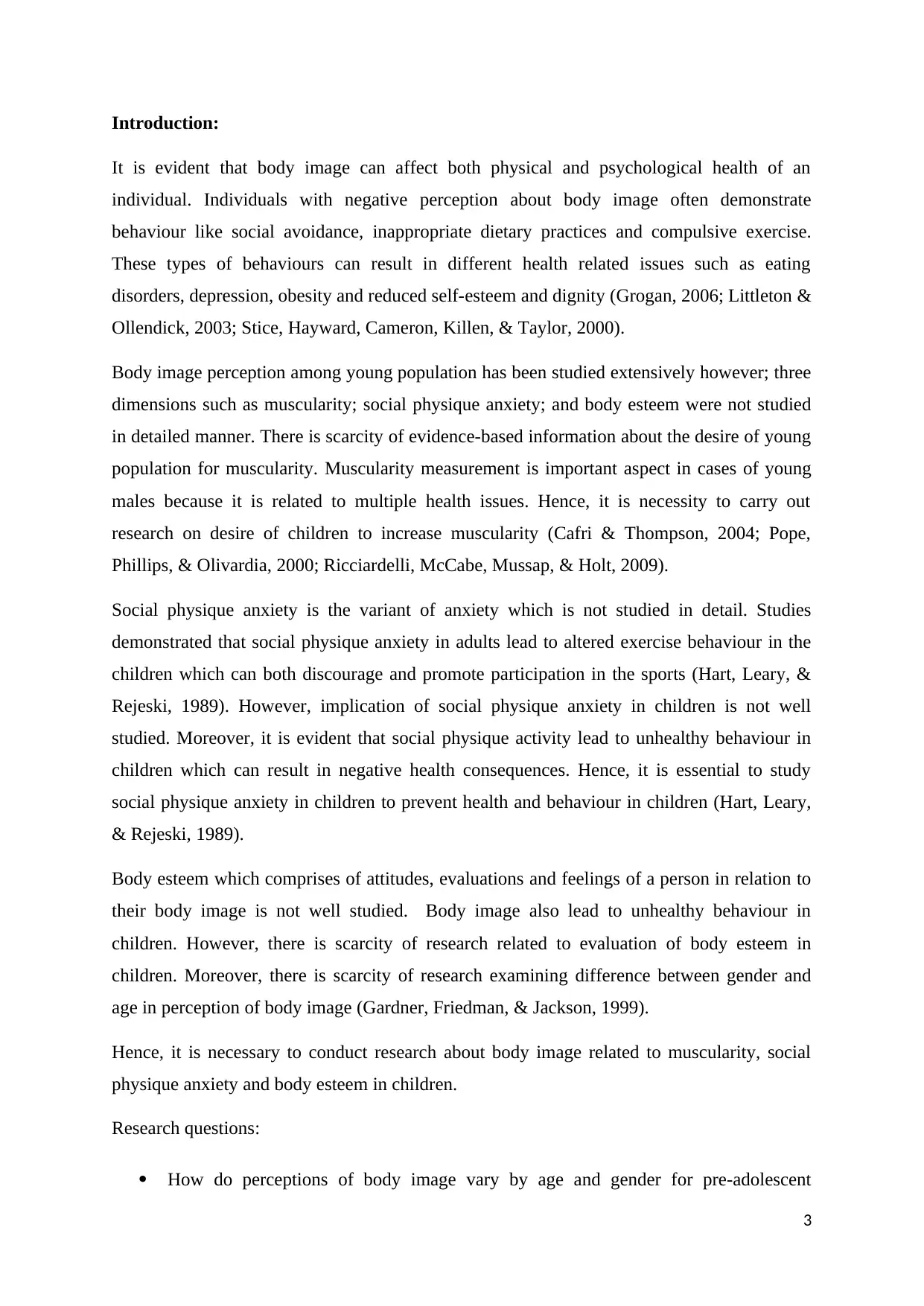
Introduction:
It is evident that body image can affect both physical and psychological health of an
individual. Individuals with negative perception about body image often demonstrate
behaviour like social avoidance, inappropriate dietary practices and compulsive exercise.
These types of behaviours can result in different health related issues such as eating
disorders, depression, obesity and reduced self-esteem and dignity (Grogan, 2006; Littleton &
Ollendick, 2003; Stice, Hayward, Cameron, Killen, & Taylor, 2000).
Body image perception among young population has been studied extensively however; three
dimensions such as muscularity; social physique anxiety; and body esteem were not studied
in detailed manner. There is scarcity of evidence-based information about the desire of young
population for muscularity. Muscularity measurement is important aspect in cases of young
males because it is related to multiple health issues. Hence, it is necessity to carry out
research on desire of children to increase muscularity (Cafri & Thompson, 2004; Pope,
Phillips, & Olivardia, 2000; Ricciardelli, McCabe, Mussap, & Holt, 2009).
Social physique anxiety is the variant of anxiety which is not studied in detail. Studies
demonstrated that social physique anxiety in adults lead to altered exercise behaviour in the
children which can both discourage and promote participation in the sports (Hart, Leary, &
Rejeski, 1989). However, implication of social physique anxiety in children is not well
studied. Moreover, it is evident that social physique activity lead to unhealthy behaviour in
children which can result in negative health consequences. Hence, it is essential to study
social physique anxiety in children to prevent health and behaviour in children (Hart, Leary,
& Rejeski, 1989).
Body esteem which comprises of attitudes, evaluations and feelings of a person in relation to
their body image is not well studied. Body image also lead to unhealthy behaviour in
children. However, there is scarcity of research related to evaluation of body esteem in
children. Moreover, there is scarcity of research examining difference between gender and
age in perception of body image (Gardner, Friedman, & Jackson, 1999).
Hence, it is necessary to conduct research about body image related to muscularity, social
physique anxiety and body esteem in children.
Research questions:
How do perceptions of body image vary by age and gender for pre-adolescent
3
It is evident that body image can affect both physical and psychological health of an
individual. Individuals with negative perception about body image often demonstrate
behaviour like social avoidance, inappropriate dietary practices and compulsive exercise.
These types of behaviours can result in different health related issues such as eating
disorders, depression, obesity and reduced self-esteem and dignity (Grogan, 2006; Littleton &
Ollendick, 2003; Stice, Hayward, Cameron, Killen, & Taylor, 2000).
Body image perception among young population has been studied extensively however; three
dimensions such as muscularity; social physique anxiety; and body esteem were not studied
in detailed manner. There is scarcity of evidence-based information about the desire of young
population for muscularity. Muscularity measurement is important aspect in cases of young
males because it is related to multiple health issues. Hence, it is necessity to carry out
research on desire of children to increase muscularity (Cafri & Thompson, 2004; Pope,
Phillips, & Olivardia, 2000; Ricciardelli, McCabe, Mussap, & Holt, 2009).
Social physique anxiety is the variant of anxiety which is not studied in detail. Studies
demonstrated that social physique anxiety in adults lead to altered exercise behaviour in the
children which can both discourage and promote participation in the sports (Hart, Leary, &
Rejeski, 1989). However, implication of social physique anxiety in children is not well
studied. Moreover, it is evident that social physique activity lead to unhealthy behaviour in
children which can result in negative health consequences. Hence, it is essential to study
social physique anxiety in children to prevent health and behaviour in children (Hart, Leary,
& Rejeski, 1989).
Body esteem which comprises of attitudes, evaluations and feelings of a person in relation to
their body image is not well studied. Body image also lead to unhealthy behaviour in
children. However, there is scarcity of research related to evaluation of body esteem in
children. Moreover, there is scarcity of research examining difference between gender and
age in perception of body image (Gardner, Friedman, & Jackson, 1999).
Hence, it is necessary to conduct research about body image related to muscularity, social
physique anxiety and body esteem in children.
Research questions:
How do perceptions of body image vary by age and gender for pre-adolescent
3
⊘ This is a preview!⊘
Do you want full access?
Subscribe today to unlock all pages.

Trusted by 1+ million students worldwide
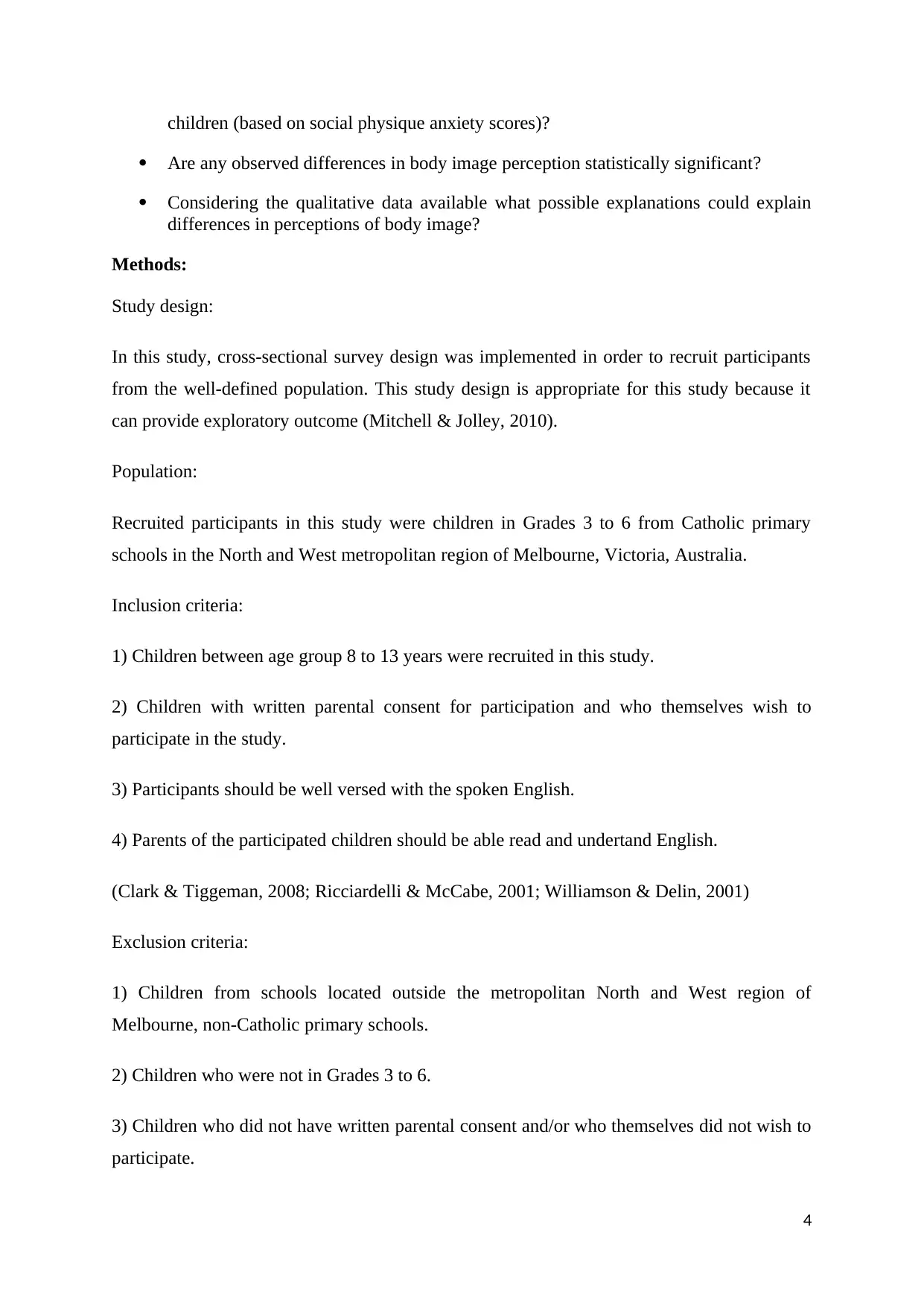
children (based on social physique anxiety scores)?
Are any observed differences in body image perception statistically significant?
Considering the qualitative data available what possible explanations could explain
differences in perceptions of body image?
Methods:
Study design:
In this study, cross-sectional survey design was implemented in order to recruit participants
from the well-defined population. This study design is appropriate for this study because it
can provide exploratory outcome (Mitchell & Jolley, 2010).
Population:
Recruited participants in this study were children in Grades 3 to 6 from Catholic primary
schools in the North and West metropolitan region of Melbourne, Victoria, Australia.
Inclusion criteria:
1) Children between age group 8 to 13 years were recruited in this study.
2) Children with written parental consent for participation and who themselves wish to
participate in the study.
3) Participants should be well versed with the spoken English.
4) Parents of the participated children should be able read and undertand English.
(Clark & Tiggeman, 2008; Ricciardelli & McCabe, 2001; Williamson & Delin, 2001)
Exclusion criteria:
1) Children from schools located outside the metropolitan North and West region of
Melbourne, non-Catholic primary schools.
2) Children who were not in Grades 3 to 6.
3) Children who did not have written parental consent and/or who themselves did not wish to
participate.
4
Are any observed differences in body image perception statistically significant?
Considering the qualitative data available what possible explanations could explain
differences in perceptions of body image?
Methods:
Study design:
In this study, cross-sectional survey design was implemented in order to recruit participants
from the well-defined population. This study design is appropriate for this study because it
can provide exploratory outcome (Mitchell & Jolley, 2010).
Population:
Recruited participants in this study were children in Grades 3 to 6 from Catholic primary
schools in the North and West metropolitan region of Melbourne, Victoria, Australia.
Inclusion criteria:
1) Children between age group 8 to 13 years were recruited in this study.
2) Children with written parental consent for participation and who themselves wish to
participate in the study.
3) Participants should be well versed with the spoken English.
4) Parents of the participated children should be able read and undertand English.
(Clark & Tiggeman, 2008; Ricciardelli & McCabe, 2001; Williamson & Delin, 2001)
Exclusion criteria:
1) Children from schools located outside the metropolitan North and West region of
Melbourne, non-Catholic primary schools.
2) Children who were not in Grades 3 to 6.
3) Children who did not have written parental consent and/or who themselves did not wish to
participate.
4
Paraphrase This Document
Need a fresh take? Get an instant paraphrase of this document with our AI Paraphraser
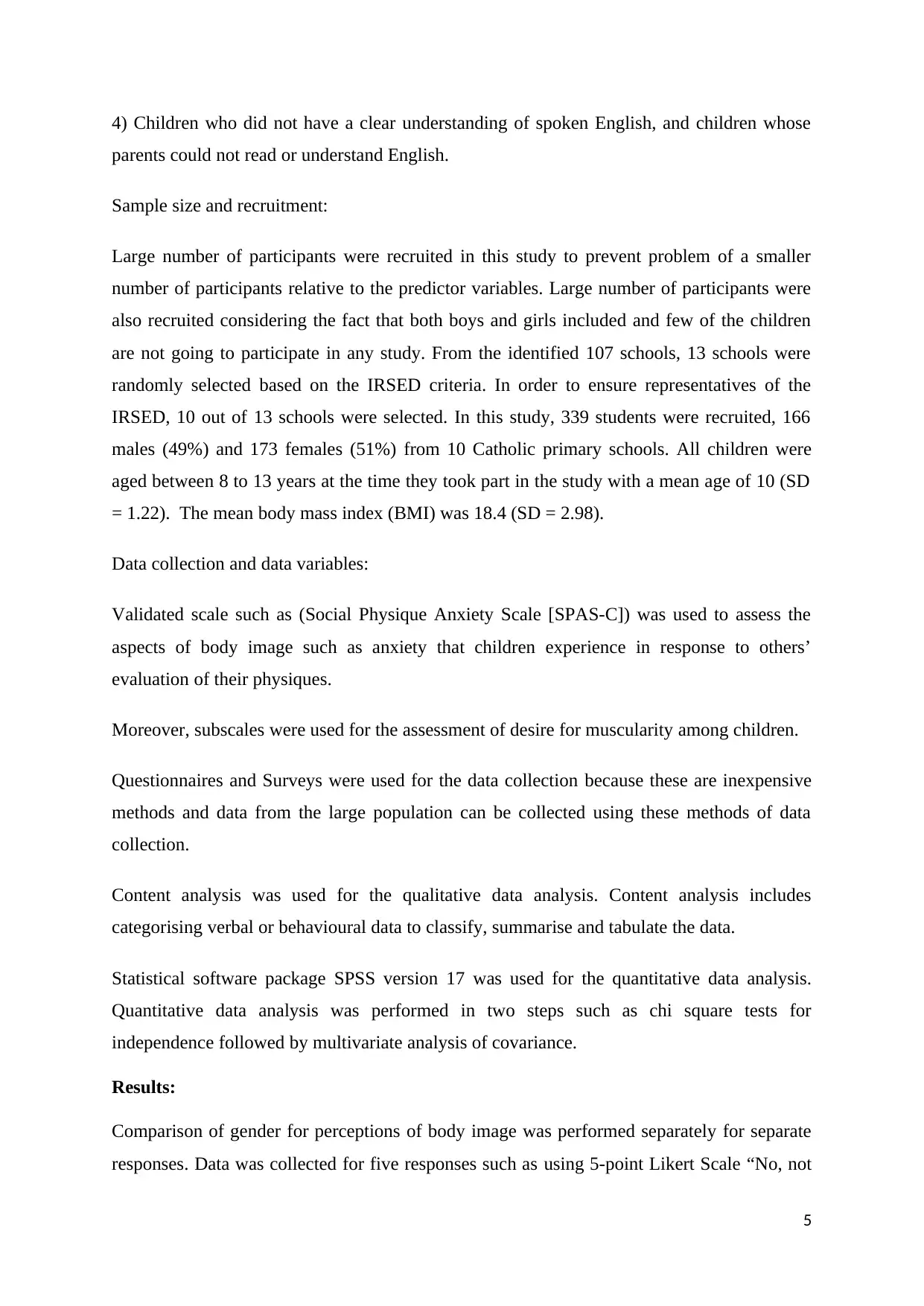
4) Children who did not have a clear understanding of spoken English, and children whose
parents could not read or understand English.
Sample size and recruitment:
Large number of participants were recruited in this study to prevent problem of a smaller
number of participants relative to the predictor variables. Large number of participants were
also recruited considering the fact that both boys and girls included and few of the children
are not going to participate in any study. From the identified 107 schools, 13 schools were
randomly selected based on the IRSED criteria. In order to ensure representatives of the
IRSED, 10 out of 13 schools were selected. In this study, 339 students were recruited, 166
males (49%) and 173 females (51%) from 10 Catholic primary schools. All children were
aged between 8 to 13 years at the time they took part in the study with a mean age of 10 (SD
= 1.22). The mean body mass index (BMI) was 18.4 (SD = 2.98).
Data collection and data variables:
Validated scale such as (Social Physique Anxiety Scale [SPAS-C]) was used to assess the
aspects of body image such as anxiety that children experience in response to others’
evaluation of their physiques.
Moreover, subscales were used for the assessment of desire for muscularity among children.
Questionnaires and Surveys were used for the data collection because these are inexpensive
methods and data from the large population can be collected using these methods of data
collection.
Content analysis was used for the qualitative data analysis. Content analysis includes
categorising verbal or behavioural data to classify, summarise and tabulate the data.
Statistical software package SPSS version 17 was used for the quantitative data analysis.
Quantitative data analysis was performed in two steps such as chi square tests for
independence followed by multivariate analysis of covariance.
Results:
Comparison of gender for perceptions of body image was performed separately for separate
responses. Data was collected for five responses such as using 5-point Likert Scale “No, not
5
parents could not read or understand English.
Sample size and recruitment:
Large number of participants were recruited in this study to prevent problem of a smaller
number of participants relative to the predictor variables. Large number of participants were
also recruited considering the fact that both boys and girls included and few of the children
are not going to participate in any study. From the identified 107 schools, 13 schools were
randomly selected based on the IRSED criteria. In order to ensure representatives of the
IRSED, 10 out of 13 schools were selected. In this study, 339 students were recruited, 166
males (49%) and 173 females (51%) from 10 Catholic primary schools. All children were
aged between 8 to 13 years at the time they took part in the study with a mean age of 10 (SD
= 1.22). The mean body mass index (BMI) was 18.4 (SD = 2.98).
Data collection and data variables:
Validated scale such as (Social Physique Anxiety Scale [SPAS-C]) was used to assess the
aspects of body image such as anxiety that children experience in response to others’
evaluation of their physiques.
Moreover, subscales were used for the assessment of desire for muscularity among children.
Questionnaires and Surveys were used for the data collection because these are inexpensive
methods and data from the large population can be collected using these methods of data
collection.
Content analysis was used for the qualitative data analysis. Content analysis includes
categorising verbal or behavioural data to classify, summarise and tabulate the data.
Statistical software package SPSS version 17 was used for the quantitative data analysis.
Quantitative data analysis was performed in two steps such as chi square tests for
independence followed by multivariate analysis of covariance.
Results:
Comparison of gender for perceptions of body image was performed separately for separate
responses. Data was collected for five responses such as using 5-point Likert Scale “No, not
5

at all”, “No, not much”, “Don’t know, not sure”, “Yes, a little” and “Yes, a lot” using 5-point
Likert Scale. Mean values obtained for males and females for “No, not at all” were
20.20±3.12 and 16.20±4.14 respectively. There was no statistical difference between male
and female children with p value 0.2313 using t-test. Moreover, no statistical difference was
observed using Chi-square test with p value 0.4231. Mean values obtained for males and
females for “No, not much” were 26.60±5.08 and 20.60±5.22 respectively. There was no
statistical difference between male and female with p value 0.2171 using t-test. Moreover, no
statistical difference was observed using Chi-square test with p value 0.3994. Mean values
obtained for males and females for “Don’t know, not sure” were 12.20±4.04 and 12.40±4.25
respectively. There was no statistical difference between male and female children with p
value 0.4868 using t-test. Moreover, no statistical difference was observed using Chi-square
test with p value 0.0995. Mean values obtained for males and females for “Yes, a little” were
19.60±2.50 and 25.60±5.41 respectively. There was no statistical difference between male
and female children with p value 0.1721 using t-test. Moreover, no statistical difference was
observed using Chi-square test with p value 0.4231. Mean values obtained for males and
females for “Yes, a lot” were 21.40±7.54 and 25.20±6.39 respectively. There was no
statistical difference between male and female with p value 0.3555 using t-test. Moreover, no
statistical difference was observed using Chi-square test with p value 0.5000. Comparison
among children of different age for perceptions of body image was performed separately for
separate responses. There is no statistically significant difference between the combined
negative perception (“No, not at all”, “No, not much”) and positive perception (“Yes, a
little”, and “Yes, a lot”) among males and females.
Graph 1: Comparison of perception of body image among male and female children.
6
Likert Scale. Mean values obtained for males and females for “No, not at all” were
20.20±3.12 and 16.20±4.14 respectively. There was no statistical difference between male
and female children with p value 0.2313 using t-test. Moreover, no statistical difference was
observed using Chi-square test with p value 0.4231. Mean values obtained for males and
females for “No, not much” were 26.60±5.08 and 20.60±5.22 respectively. There was no
statistical difference between male and female with p value 0.2171 using t-test. Moreover, no
statistical difference was observed using Chi-square test with p value 0.3994. Mean values
obtained for males and females for “Don’t know, not sure” were 12.20±4.04 and 12.40±4.25
respectively. There was no statistical difference between male and female children with p
value 0.4868 using t-test. Moreover, no statistical difference was observed using Chi-square
test with p value 0.0995. Mean values obtained for males and females for “Yes, a little” were
19.60±2.50 and 25.60±5.41 respectively. There was no statistical difference between male
and female children with p value 0.1721 using t-test. Moreover, no statistical difference was
observed using Chi-square test with p value 0.4231. Mean values obtained for males and
females for “Yes, a lot” were 21.40±7.54 and 25.20±6.39 respectively. There was no
statistical difference between male and female with p value 0.3555 using t-test. Moreover, no
statistical difference was observed using Chi-square test with p value 0.5000. Comparison
among children of different age for perceptions of body image was performed separately for
separate responses. There is no statistically significant difference between the combined
negative perception (“No, not at all”, “No, not much”) and positive perception (“Yes, a
little”, and “Yes, a lot”) among males and females.
Graph 1: Comparison of perception of body image among male and female children.
6
⊘ This is a preview!⊘
Do you want full access?
Subscribe today to unlock all pages.

Trusted by 1+ million students worldwide
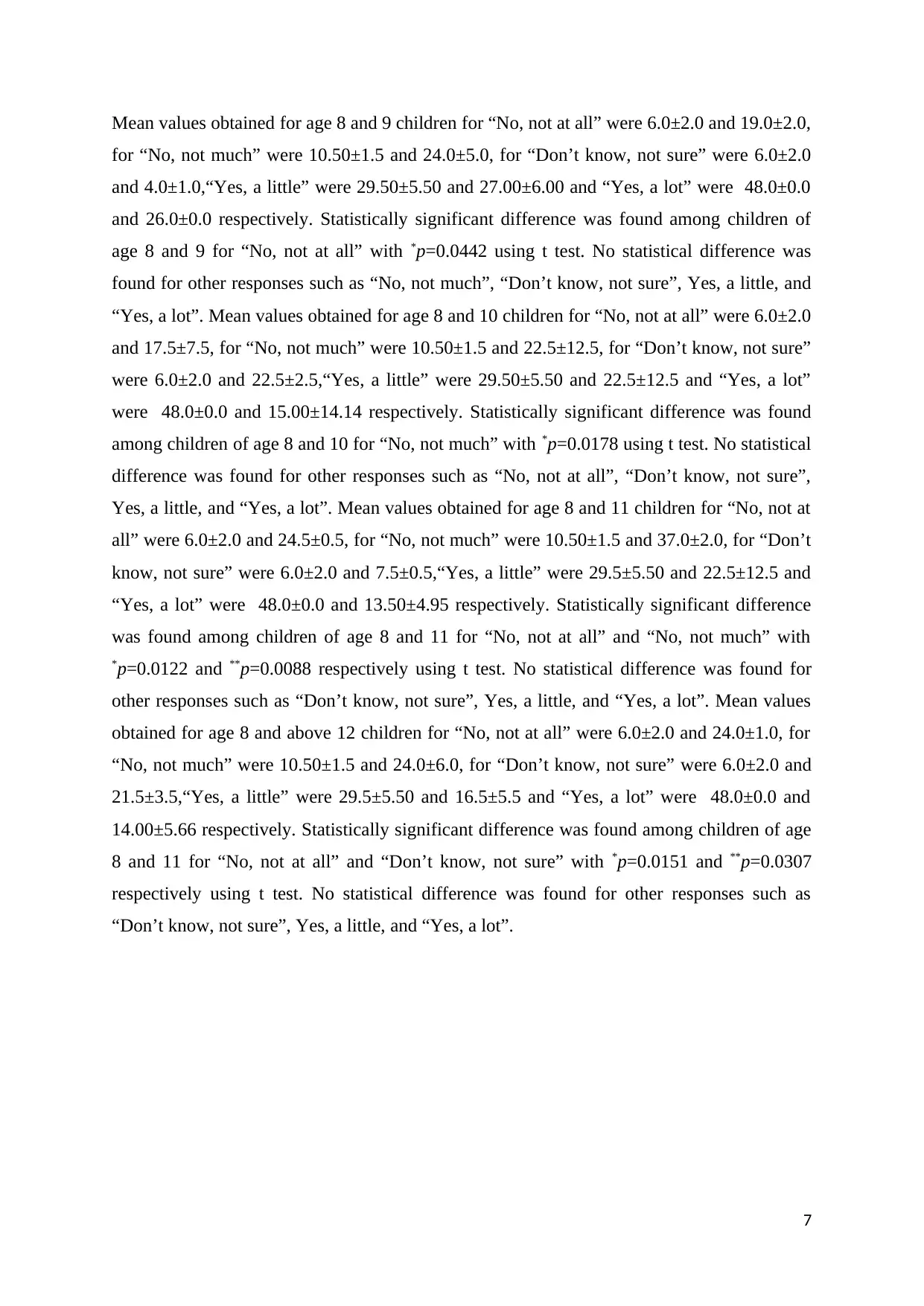
Mean values obtained for age 8 and 9 children for “No, not at all” were 6.0±2.0 and 19.0±2.0,
for “No, not much” were 10.50±1.5 and 24.0±5.0, for “Don’t know, not sure” were 6.0±2.0
and 4.0±1.0,“Yes, a little” were 29.50±5.50 and 27.00±6.00 and “Yes, a lot” were 48.0±0.0
and 26.0±0.0 respectively. Statistically significant difference was found among children of
age 8 and 9 for “No, not at all” with *p=0.0442 using t test. No statistical difference was
found for other responses such as “No, not much”, “Don’t know, not sure”, Yes, a little, and
“Yes, a lot”. Mean values obtained for age 8 and 10 children for “No, not at all” were 6.0±2.0
and 17.5±7.5, for “No, not much” were 10.50±1.5 and 22.5±12.5, for “Don’t know, not sure”
were 6.0±2.0 and 22.5±2.5,“Yes, a little” were 29.50±5.50 and 22.5±12.5 and “Yes, a lot”
were 48.0±0.0 and 15.00±14.14 respectively. Statistically significant difference was found
among children of age 8 and 10 for “No, not much” with *p=0.0178 using t test. No statistical
difference was found for other responses such as “No, not at all”, “Don’t know, not sure”,
Yes, a little, and “Yes, a lot”. Mean values obtained for age 8 and 11 children for “No, not at
all” were 6.0±2.0 and 24.5±0.5, for “No, not much” were 10.50±1.5 and 37.0±2.0, for “Don’t
know, not sure” were 6.0±2.0 and 7.5±0.5,“Yes, a little” were 29.5±5.50 and 22.5±12.5 and
“Yes, a lot” were 48.0±0.0 and 13.50±4.95 respectively. Statistically significant difference
was found among children of age 8 and 11 for “No, not at all” and “No, not much” with
*p=0.0122 and **p=0.0088 respectively using t test. No statistical difference was found for
other responses such as “Don’t know, not sure”, Yes, a little, and “Yes, a lot”. Mean values
obtained for age 8 and above 12 children for “No, not at all” were 6.0±2.0 and 24.0±1.0, for
“No, not much” were 10.50±1.5 and 24.0±6.0, for “Don’t know, not sure” were 6.0±2.0 and
21.5±3.5,“Yes, a little” were 29.5±5.50 and 16.5±5.5 and “Yes, a lot” were 48.0±0.0 and
14.00±5.66 respectively. Statistically significant difference was found among children of age
8 and 11 for “No, not at all” and “Don’t know, not sure” with *p=0.0151 and **p=0.0307
respectively using t test. No statistical difference was found for other responses such as
“Don’t know, not sure”, Yes, a little, and “Yes, a lot”.
7
for “No, not much” were 10.50±1.5 and 24.0±5.0, for “Don’t know, not sure” were 6.0±2.0
and 4.0±1.0,“Yes, a little” were 29.50±5.50 and 27.00±6.00 and “Yes, a lot” were 48.0±0.0
and 26.0±0.0 respectively. Statistically significant difference was found among children of
age 8 and 9 for “No, not at all” with *p=0.0442 using t test. No statistical difference was
found for other responses such as “No, not much”, “Don’t know, not sure”, Yes, a little, and
“Yes, a lot”. Mean values obtained for age 8 and 10 children for “No, not at all” were 6.0±2.0
and 17.5±7.5, for “No, not much” were 10.50±1.5 and 22.5±12.5, for “Don’t know, not sure”
were 6.0±2.0 and 22.5±2.5,“Yes, a little” were 29.50±5.50 and 22.5±12.5 and “Yes, a lot”
were 48.0±0.0 and 15.00±14.14 respectively. Statistically significant difference was found
among children of age 8 and 10 for “No, not much” with *p=0.0178 using t test. No statistical
difference was found for other responses such as “No, not at all”, “Don’t know, not sure”,
Yes, a little, and “Yes, a lot”. Mean values obtained for age 8 and 11 children for “No, not at
all” were 6.0±2.0 and 24.5±0.5, for “No, not much” were 10.50±1.5 and 37.0±2.0, for “Don’t
know, not sure” were 6.0±2.0 and 7.5±0.5,“Yes, a little” were 29.5±5.50 and 22.5±12.5 and
“Yes, a lot” were 48.0±0.0 and 13.50±4.95 respectively. Statistically significant difference
was found among children of age 8 and 11 for “No, not at all” and “No, not much” with
*p=0.0122 and **p=0.0088 respectively using t test. No statistical difference was found for
other responses such as “Don’t know, not sure”, Yes, a little, and “Yes, a lot”. Mean values
obtained for age 8 and above 12 children for “No, not at all” were 6.0±2.0 and 24.0±1.0, for
“No, not much” were 10.50±1.5 and 24.0±6.0, for “Don’t know, not sure” were 6.0±2.0 and
21.5±3.5,“Yes, a little” were 29.5±5.50 and 16.5±5.5 and “Yes, a lot” were 48.0±0.0 and
14.00±5.66 respectively. Statistically significant difference was found among children of age
8 and 11 for “No, not at all” and “Don’t know, not sure” with *p=0.0151 and **p=0.0307
respectively using t test. No statistical difference was found for other responses such as
“Don’t know, not sure”, Yes, a little, and “Yes, a lot”.
7
Paraphrase This Document
Need a fresh take? Get an instant paraphrase of this document with our AI Paraphraser
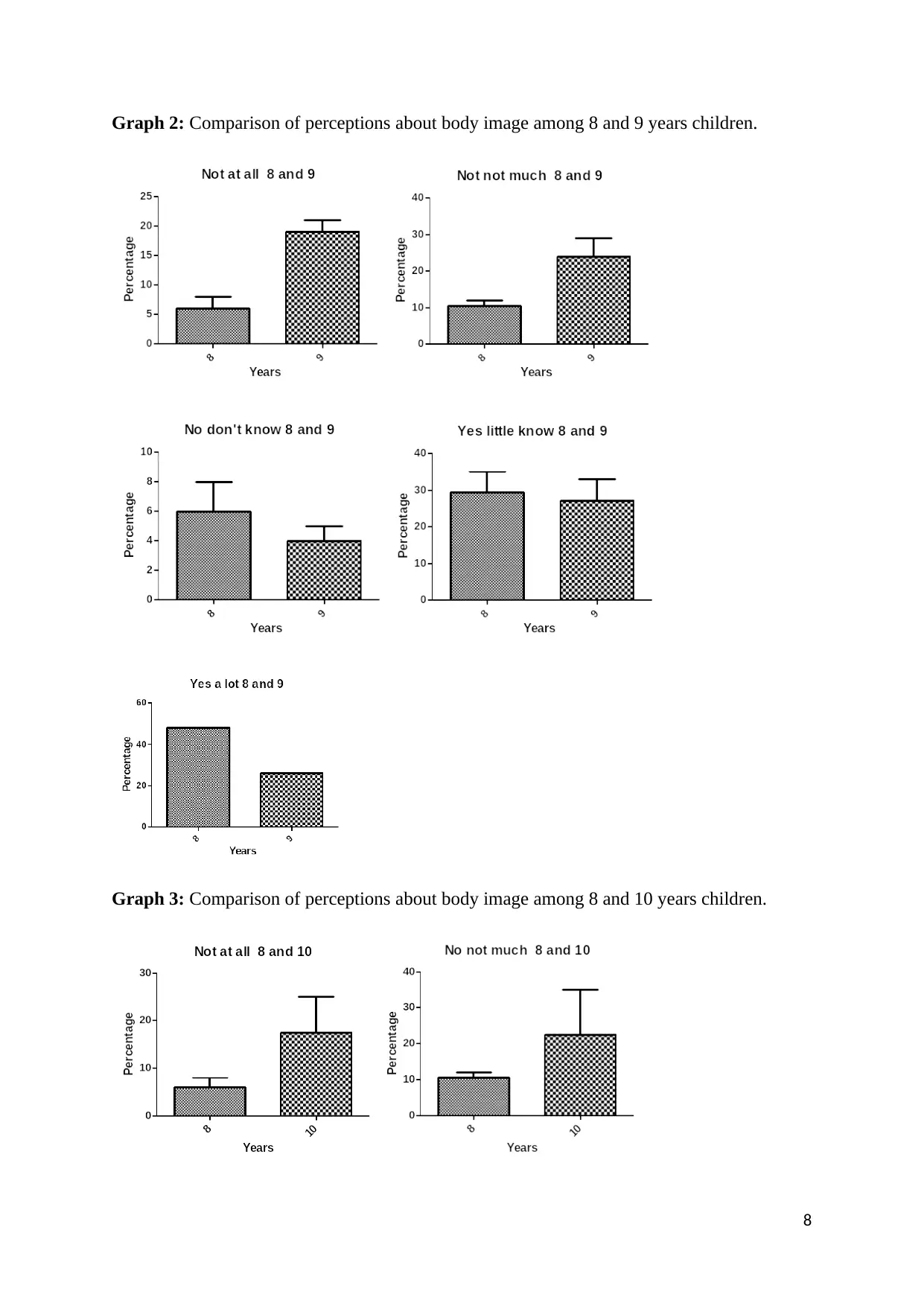
Graph 2: Comparison of perceptions about body image among 8 and 9 years children.
Graph 3: Comparison of perceptions about body image among 8 and 10 years children.
8
Graph 3: Comparison of perceptions about body image among 8 and 10 years children.
8
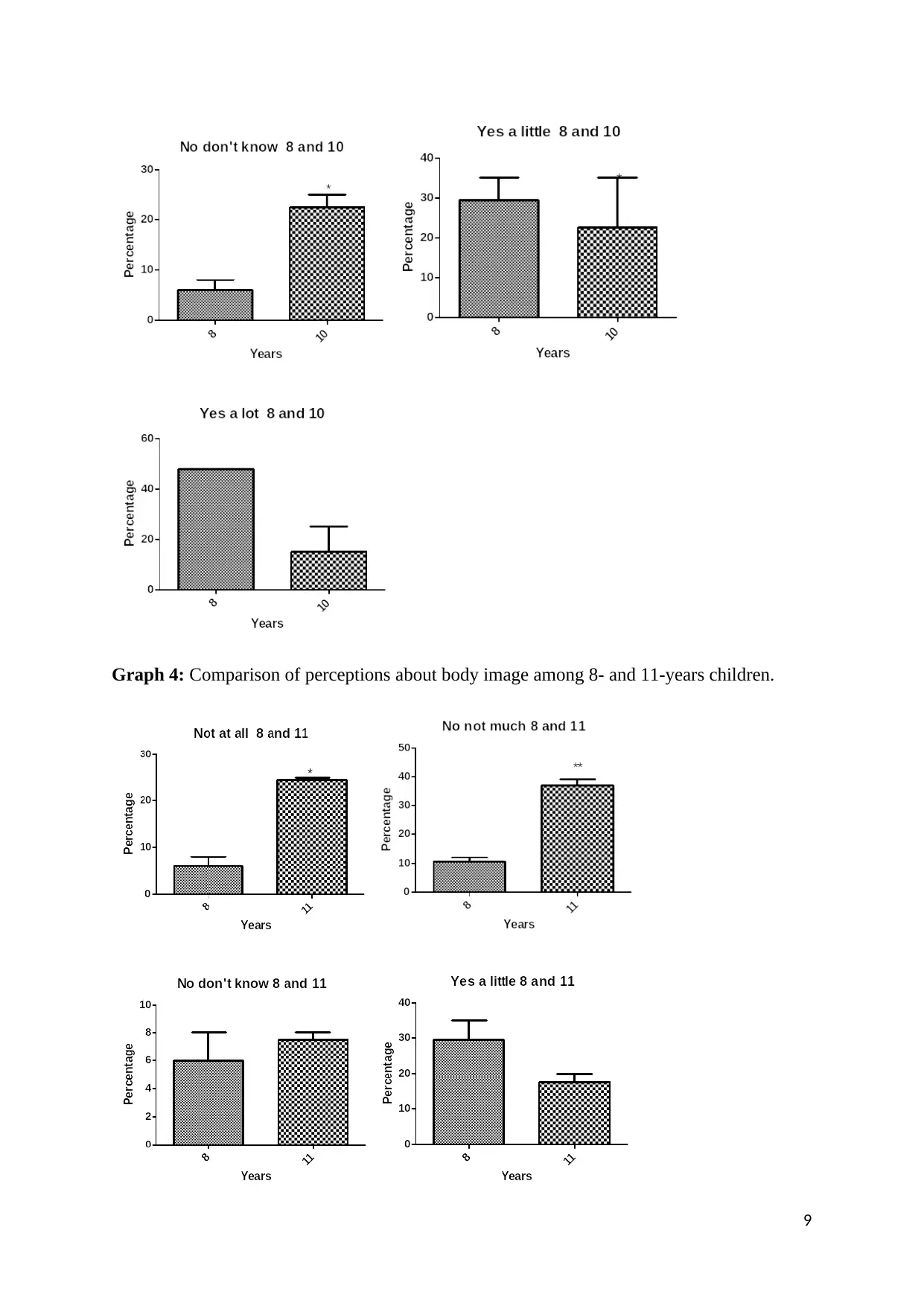
Graph 4: Comparison of perceptions about body image among 8- and 11-years children.
9
9
⊘ This is a preview!⊘
Do you want full access?
Subscribe today to unlock all pages.

Trusted by 1+ million students worldwide
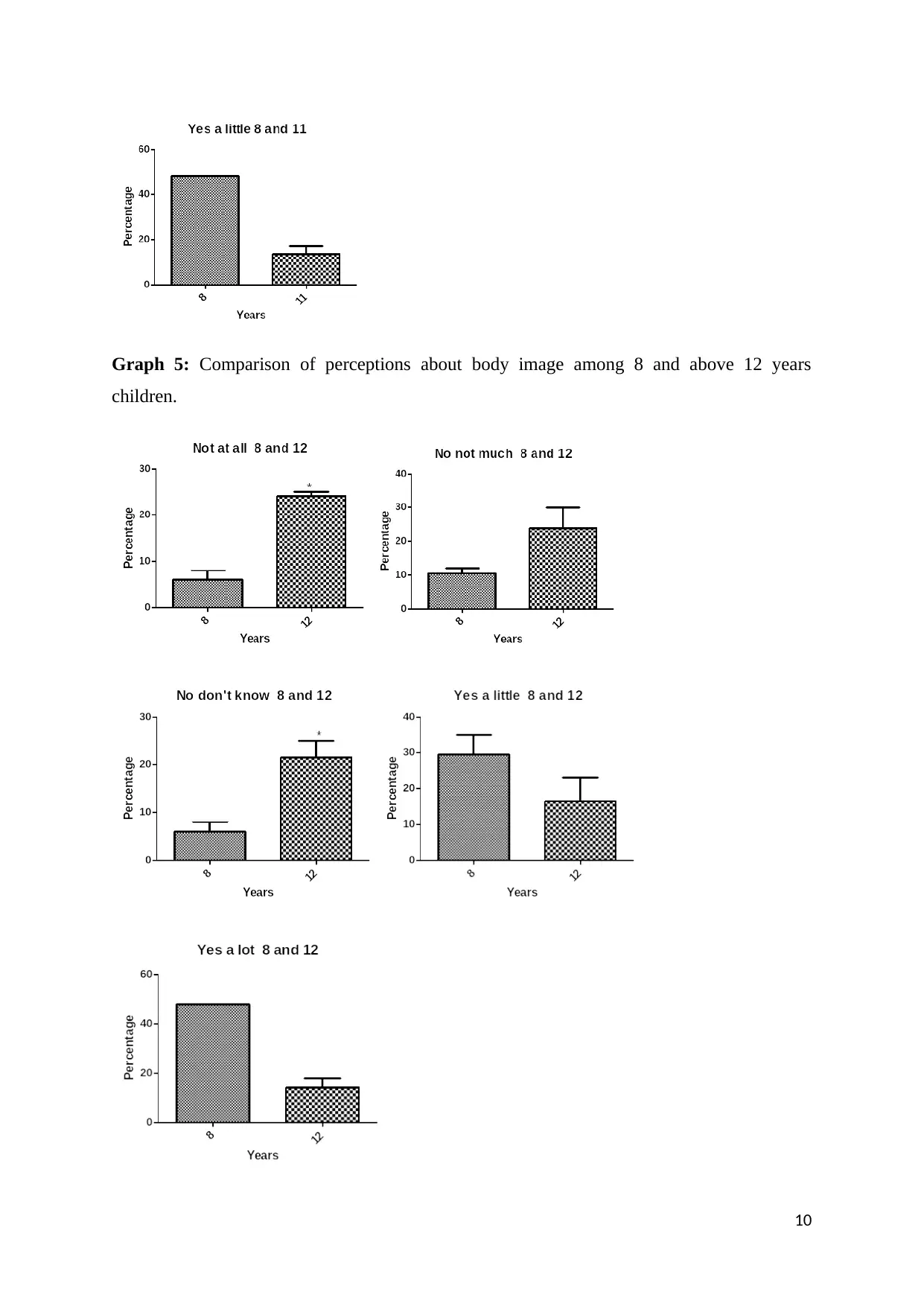
Graph 5: Comparison of perceptions about body image among 8 and above 12 years
children.
10
children.
10
Paraphrase This Document
Need a fresh take? Get an instant paraphrase of this document with our AI Paraphraser
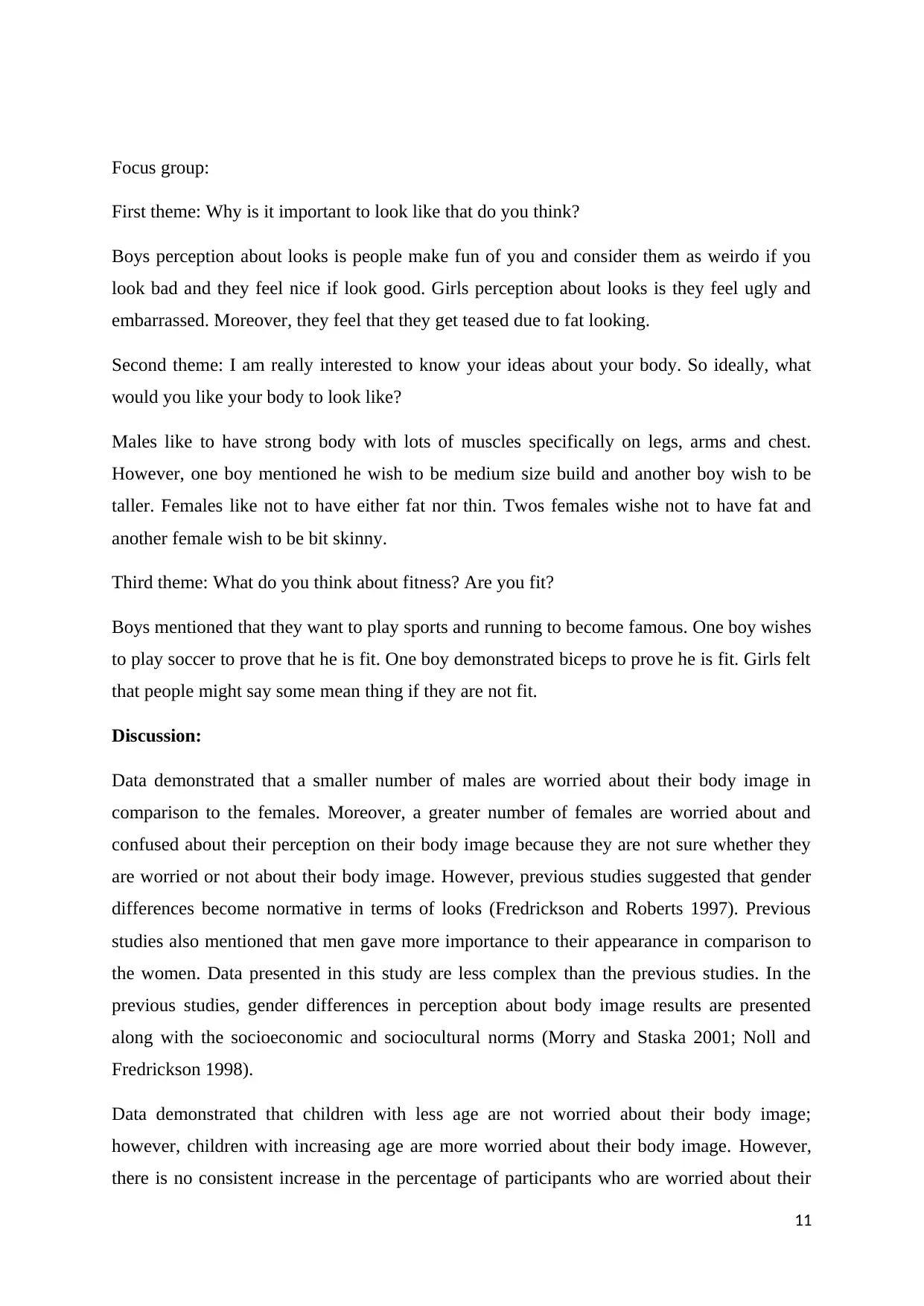
Focus group:
First theme: Why is it important to look like that do you think?
Boys perception about looks is people make fun of you and consider them as weirdo if you
look bad and they feel nice if look good. Girls perception about looks is they feel ugly and
embarrassed. Moreover, they feel that they get teased due to fat looking.
Second theme: I am really interested to know your ideas about your body. So ideally, what
would you like your body to look like?
Males like to have strong body with lots of muscles specifically on legs, arms and chest.
However, one boy mentioned he wish to be medium size build and another boy wish to be
taller. Females like not to have either fat nor thin. Twos females wishe not to have fat and
another female wish to be bit skinny.
Third theme: What do you think about fitness? Are you fit?
Boys mentioned that they want to play sports and running to become famous. One boy wishes
to play soccer to prove that he is fit. One boy demonstrated biceps to prove he is fit. Girls felt
that people might say some mean thing if they are not fit.
Discussion:
Data demonstrated that a smaller number of males are worried about their body image in
comparison to the females. Moreover, a greater number of females are worried about and
confused about their perception on their body image because they are not sure whether they
are worried or not about their body image. However, previous studies suggested that gender
differences become normative in terms of looks (Fredrickson and Roberts 1997). Previous
studies also mentioned that men gave more importance to their appearance in comparison to
the women. Data presented in this study are less complex than the previous studies. In the
previous studies, gender differences in perception about body image results are presented
along with the socioeconomic and sociocultural norms (Morry and Staska 2001; Noll and
Fredrickson 1998).
Data demonstrated that children with less age are not worried about their body image;
however, children with increasing age are more worried about their body image. However,
there is no consistent increase in the percentage of participants who are worried about their
11
First theme: Why is it important to look like that do you think?
Boys perception about looks is people make fun of you and consider them as weirdo if you
look bad and they feel nice if look good. Girls perception about looks is they feel ugly and
embarrassed. Moreover, they feel that they get teased due to fat looking.
Second theme: I am really interested to know your ideas about your body. So ideally, what
would you like your body to look like?
Males like to have strong body with lots of muscles specifically on legs, arms and chest.
However, one boy mentioned he wish to be medium size build and another boy wish to be
taller. Females like not to have either fat nor thin. Twos females wishe not to have fat and
another female wish to be bit skinny.
Third theme: What do you think about fitness? Are you fit?
Boys mentioned that they want to play sports and running to become famous. One boy wishes
to play soccer to prove that he is fit. One boy demonstrated biceps to prove he is fit. Girls felt
that people might say some mean thing if they are not fit.
Discussion:
Data demonstrated that a smaller number of males are worried about their body image in
comparison to the females. Moreover, a greater number of females are worried about and
confused about their perception on their body image because they are not sure whether they
are worried or not about their body image. However, previous studies suggested that gender
differences become normative in terms of looks (Fredrickson and Roberts 1997). Previous
studies also mentioned that men gave more importance to their appearance in comparison to
the women. Data presented in this study are less complex than the previous studies. In the
previous studies, gender differences in perception about body image results are presented
along with the socioeconomic and sociocultural norms (Morry and Staska 2001; Noll and
Fredrickson 1998).
Data demonstrated that children with less age are not worried about their body image;
however, children with increasing age are more worried about their body image. However,
there is no consistent increase in the percentage of participants who are worried about their
11
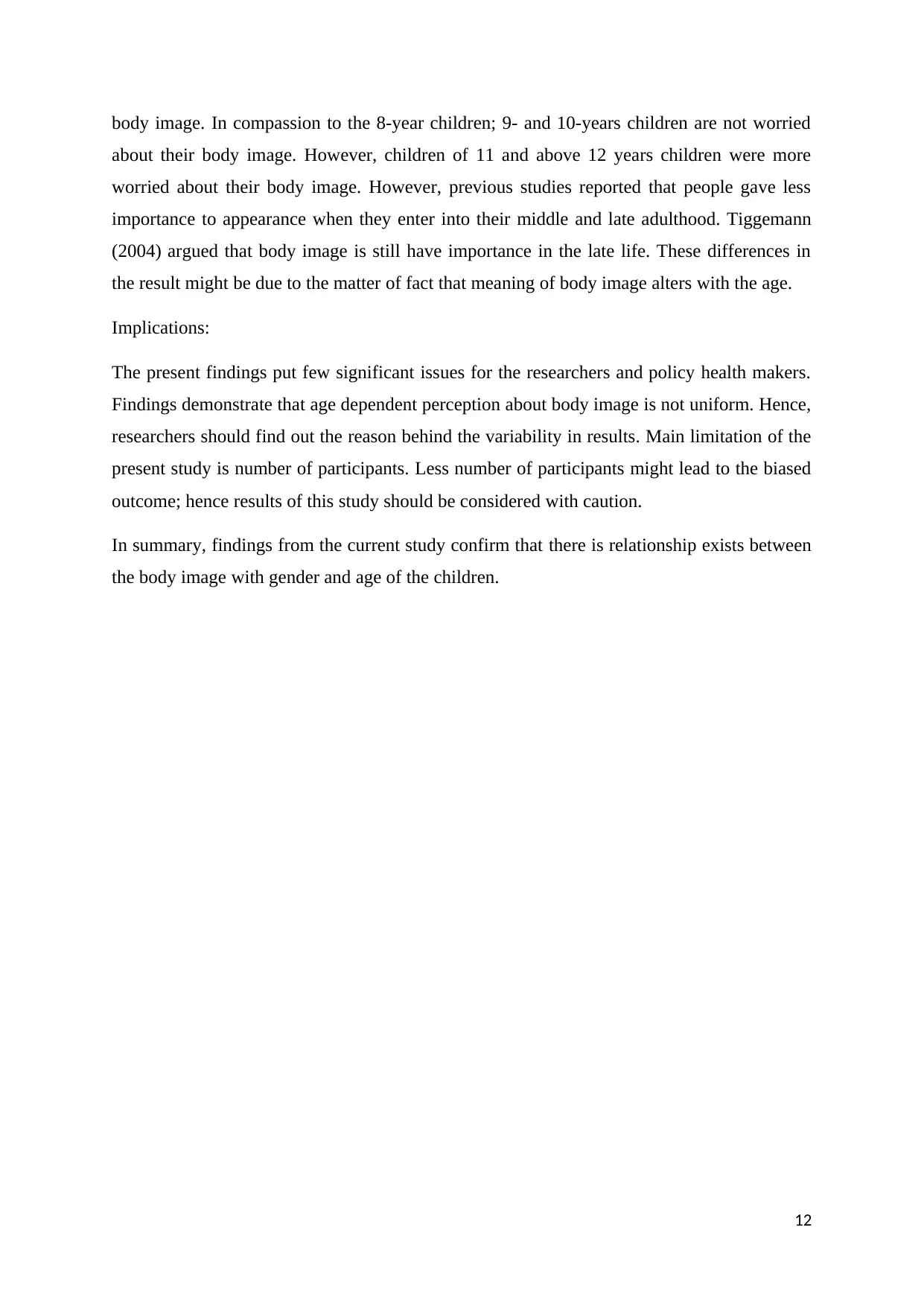
body image. In compassion to the 8-year children; 9- and 10-years children are not worried
about their body image. However, children of 11 and above 12 years children were more
worried about their body image. However, previous studies reported that people gave less
importance to appearance when they enter into their middle and late adulthood. Tiggemann
(2004) argued that body image is still have importance in the late life. These differences in
the result might be due to the matter of fact that meaning of body image alters with the age.
Implications:
The present findings put few significant issues for the researchers and policy health makers.
Findings demonstrate that age dependent perception about body image is not uniform. Hence,
researchers should find out the reason behind the variability in results. Main limitation of the
present study is number of participants. Less number of participants might lead to the biased
outcome; hence results of this study should be considered with caution.
In summary, findings from the current study confirm that there is relationship exists between
the body image with gender and age of the children.
12
about their body image. However, children of 11 and above 12 years children were more
worried about their body image. However, previous studies reported that people gave less
importance to appearance when they enter into their middle and late adulthood. Tiggemann
(2004) argued that body image is still have importance in the late life. These differences in
the result might be due to the matter of fact that meaning of body image alters with the age.
Implications:
The present findings put few significant issues for the researchers and policy health makers.
Findings demonstrate that age dependent perception about body image is not uniform. Hence,
researchers should find out the reason behind the variability in results. Main limitation of the
present study is number of participants. Less number of participants might lead to the biased
outcome; hence results of this study should be considered with caution.
In summary, findings from the current study confirm that there is relationship exists between
the body image with gender and age of the children.
12
⊘ This is a preview!⊘
Do you want full access?
Subscribe today to unlock all pages.

Trusted by 1+ million students worldwide
1 out of 15
Related Documents
Your All-in-One AI-Powered Toolkit for Academic Success.
+13062052269
info@desklib.com
Available 24*7 on WhatsApp / Email
![[object Object]](/_next/static/media/star-bottom.7253800d.svg)
Unlock your academic potential
Copyright © 2020–2025 A2Z Services. All Rights Reserved. Developed and managed by ZUCOL.





